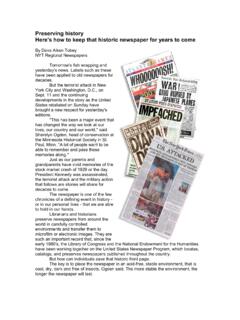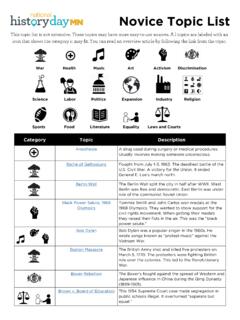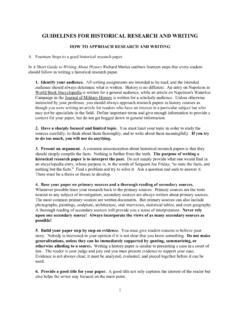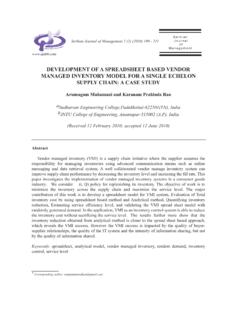Transcription of Minnesota Historical Society Standards for Processing ...
1 1 Minnesota Historical Society Standards for Processing Archaeology Collections 2 General Conservation Guidelines for the Field and the Lab It is best to take a minimal and cautious approach to treating objects. Oftentimes, it is best to do nothing at all to an object and suffer a minor loss than to use a risky and dangerous treatment and lose the entire object and its intrinsic information. 1) BE PREPARED!! Make the effort to know what objects and materials may be recovered, and have the proper supplies and equipment on hand. Contact a qualified professional archaeological conservator for advice before you go into the field. 2) It is the archaeologist s responsibility and obligation to become familiar with new field manuals that have been published from the perspective of modern conservation practices (see attached references). It is no longer acceptable to rely on conservation advice from other fields such as paleontology or geology or on outdated recipes and publications.
2 3) Acrylic thermoplastic resins (such as B-72) are the only glues that are approved for conservation use. Most commercial adhesive preparations are not approved by MHS archaeological conservators for use on archaeological objects due to a lack of chemical stability. Cellulose nitrate glues such as Duco Household Cement are completely unacceptable due to long-term instability and other technical problems. Poly vinyl acetate (PVAc) formulations may be used in some circumstances with the assistance of the conservators. 4) Avoid chemical cleaners of any kind in the cleaning water for ceramics, bones, and other organic materials. A conservator must be contacted if it is deemed that such a cleaner needs to be used to remove a mineral crust or stain. 5) All iron objects do not need to be cleaned by the electrolytic method, as has become common in historic archaeological lab methodology.
3 This method may actually destroy valuable artifactual information. A qualified conservator should be consulted before proceeding. 6) Thorough photographic and written documentation must be done before, during, and after any conservation treatments, such as reconstruction, are performed. Field removal in situ consolidation and block removal must also be photographically and graphically documented. This documentation must become part of the excavation records. Don t hesitate to contact a conservator when you encounter a recovery problem that is beyond your knowledge or experience. Please contact the Daniels Object Conservation Laboratory directly if you have any questions on these guidelines. (651) 297-5774 or (651) 282-2745. General numbers for MHS Conservation are: 1-800-657-3773 or 651-297-1867 A BRIEF LIST OF SUGGESTED READINGS: Collins, Chris. 1995.
4 The Care and Conservation of Paleontological Materials. Butterworth-Heinemann. The sections on sub-fossil bone are written by archaeological conservators, and the entire book contains update information. Storch, Paul. 1997. Conservation of Archaeological Shell Objects , Number 22, Sept. 1997, Conservation Notes. Texas Memorial Museum, The University of Texas at Austin, Austin, TX. Storch, Paul. 2003. Field and Laboratory Methods for Handling Osseous Materials . MHS Conservation Website. Originally published in the Conservation Notes series Number 6, November 1983, Texas Memorial Museum, The University of Texas at Austin, 2400 Trinity, Austin, TX 78705. Copies of the original can be purchased from the TMM for $ each. Cronyn, 1992. The Elements of Archaeological Conservation. Routledge, New York.
5 Hodges, 1987. In Situ Archaeological Conservation. Getty Conservation Institute, CA. Kite, M. and Thomson, R. 2006. The Conservation of Leather and Related Materials, Chapter 22: The Conservation of Archaeological Leather , Butterworth-Heinemann-Elsevier, Amsterdam. Pearson, C. 1987. Conservation of Marine Archaeological Objects. Butterworth-Heinnemann. Poirier, , and Feder, 2001. Dangerous Places: Health, Safety, and Archaeology. Bergin and Garvey, CT. 4 MHS Standards for Labeling Artifacts for Curation Cataloging Assign specific catalog numbers and label artifacts during lab analysis. Use a three- or four-part number consisting of the collection accession number (the year and collection number) and a sequential object number; or if a fourth number is used, a provenience number and an object number, such as: 2006 (year part of the collection number assigned by the Minnesota Historical Society ).
6 21 (collection number assigned by the Minnesota Historical Society ) .2 (object number assigned by the depositor) or 2006 (year part of the collection number assigned by the Minnesota Historical Society ) .46 (collection number assigned by the Minnesota Historical Society ) .15 (a number for the provenience unit assigned by the depositor) .7 (object number assigned by the depositor) Apply labels as specified in the Labeling section. Record the materials and methods used to clean and label artifacts in the project documentation. Culling Do not submit materials collected from contaminated sites. You must also remove all live ammunition, toxic or radioactive materials, asbestos, and other hazardous substances from collections before depositing collections for curation! The Minnesota Historical Society will not accept such material or human remains. Beyond the removal of hazardous materials, the Minnesota Historical Society does not have a policy regarding the culling or sampling of materials before curation.
7 Bear in mind however that when an application has been made for an Expanded Repository Agreement, the Acquisitions Committee may not accept a collection with a large quantity of low value items. Artifact sampling is the responsibility of the principal investigator and may be carried out in the field or in the lab, depending upon the methods specified in the research design. Items such as building materials and fire-cracked rock are examples of artifact classes that might commonly be culled before curation. It is essential that all decisions and actions are well documented and become part of the project record. Culled objects with the detailed descriptive and provenience information should be listed with catalog records, but marked as discarded . 5 Labeling It is essential that the catalog number remain associated with an object or a group of objects as soon as the number has been assigned.
8 An object may become inaccessible without the catalog number. For this reason, directly label all stable artifacts larger than the size of a dime. ( , lithics, glass, ceramics, bone, antler, most metals). The number must be: durable to remain legible over time, removable, should the need arise to make a change in the future, and never cause harm to the object. Applying Direct Labels Direct paper labels Paper labels may be generated from a computer and laser printer as an alternative to applying numbers using India ink and pens. Compared to traditional handwritten labels, printed labels: are more consistently legible, can be reduced in size to fit small items, can save time as the barrier layer does not need to dry to apply the paper label on top of it, and avoid the problem of finding a white background for a dark object. Materials: Acryloid B-72, 20% solution in acetone* Acrylic gloss medium, Golden Artist Colors, Inc.
9 (water-based acrylic emulsion) Acetone, 100%* Rhoplex Printer paper (acid free) & laser printer Archival paper tags with soft cotton string 2H pencil Where to Label: When applying direct labels, avoid diagnostic portions of an artifact. For example: Stone tools should be labeled on the unmodified portion, or cortex, of the tool if possible. If a tool has been bifacially worked, label the least photogenic side. Sherds should not be labeled on the broken edges because accurate reconstruction would be inhibited and would prevent observations of the ceramic body. Labels should not cover maker s marks or design elements, if possible. 6 Procedure: Choose the right barrier for the material . B-72: Most three-dimensional objects (glazed ceramics, glass, metals, stone, ivory and bone) can receive B-72 as a barrier layer for the label. Rhoplex: Some kinds of basketry, wood, shoes w/o leather soles and plastics should have Rhoplex as a barrier layer for the label.
10 Use extra care and concentration when applying barrier and surface layers as you are making an application directly on the object. A clear B-72 barrier or Rhoplex layer (whichever appropriate) is applied to the object to create a surface upon which to lay the paper number, followed by a seal that protects the number from easy removal. Make sure the surface you will mark is clean and free of corrosion It may be advantageous to number a group of objects at one time. Beware of drips sliding down your brushes. Try to remove as much excess as possible before approaching the object. 1. Barrier Layer Brush on a barrier layer of B-72 or Rhoplex (whichever is appropriate). A thin rectangular layer is applied. Its size should not be excessive, but should be able to accommodate the number and a topcoat within its boundaries. Lay the paper accession number tag on to the barrier layer when it is just tacky to the touch, OR Let the barrier layer dry completely before attempting to write the number on the layer if you are using India ink and pens.





